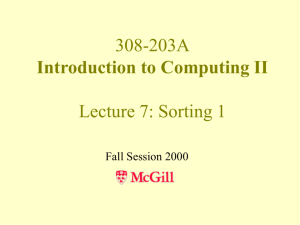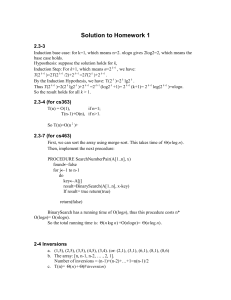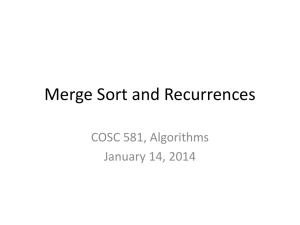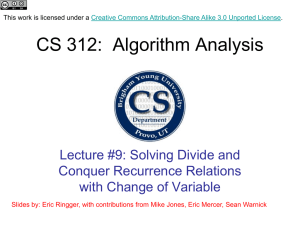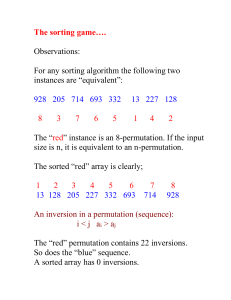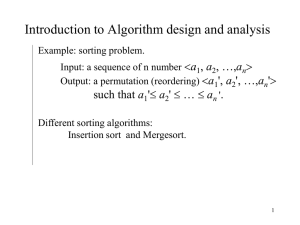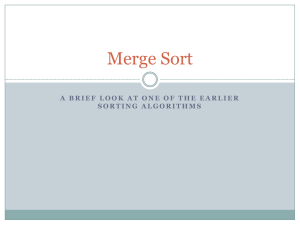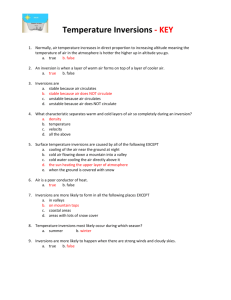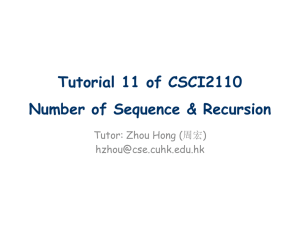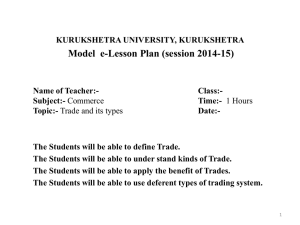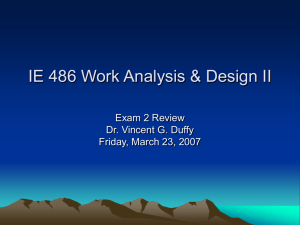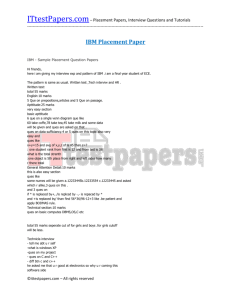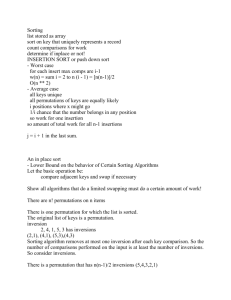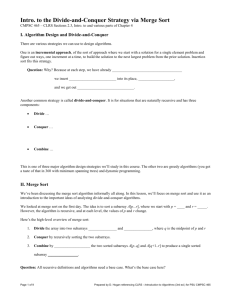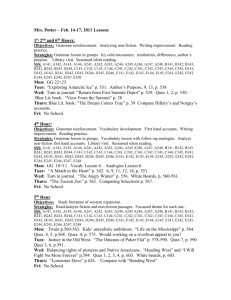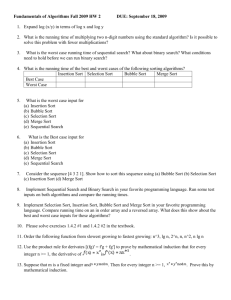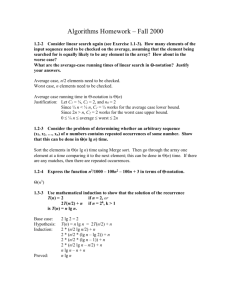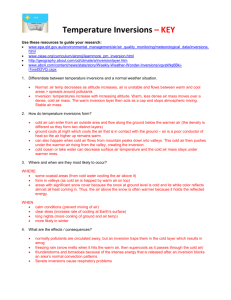powerpoint - Asian Institute of Technology
advertisement
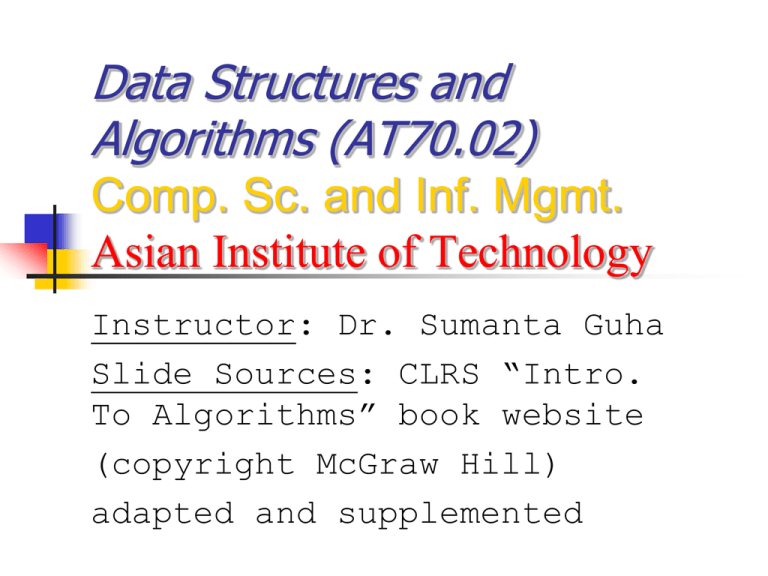
Data Structures and
Algorithms (AT70.02)
Comp. Sc. and Inf. Mgmt.
Asian Institute of Technology
Instructor: Dr. Sumanta Guha
Slide Sources: CLRS “Intro.
To Algorithms” book website
(copyright McGraw Hill)
adapted and supplemented
CLRS “Intro. To Algorithms”
Ch. 2: Getting Started
Why?
tj is the number of times the while loop test in line 5 is executed
for that value of j.
T(n) = c1n + c2(n-1) + c4(n-1) + c5 ∑j=2..n tj + c6 ∑j=2..n (tj-1)
+ c7 ∑j=2..n (tj-1) + c8(n-1)
Ques: What are the best and worst-case running times of
INSERTION-SORT?
How about average-case?
MERGE
MERGE(A, p, q, r) merges subarrays A[p..q] and A[q+1..r],
assuming that they are each already sorted.
MERGE() requires extra space
– arrays L and R – of the size
of the input + 2.
Ques: What is the time
complexity of MERGE? (Linear)
Ques: Could the merging be
done in-place ? I.e., just using
the input space (plus maybe a
constant amount of extra space).
E.g., like INSERTION-SORT.
What is the run time of your
algorithm?
Ques: Ok, how about in-place
and in linear time?!
Divide-and-Conquer: MERGESORT
Label1:
Labe12:
Label3:
Calculating the Factorial:
Use of the Stack in Recursion
Consider computing the factorial recursively:
int Fact(int n)
{ if (n < 1) return 1;
Label1: else return n*Fact(n-1);
}
1.
2.
3.
4.
5.
How is the stack used?
For a MIPS assembly language implementation of this routine
see factorialRecursive.asm in
http://www.cs.ait.ac.th/~guha/COA/Spim/ -> Examples
Very useful !! Shows how recursion is actually implemented
during run-time!
What is the run time of Fact()?
Can recursion be avoided? Replaced with iteration ? What’s
the advantage/disadvantage?
How is the stack used in MERGE-SORT ?
The recurrence for the worst-case
running time T(n) of MERGE-SORT:
T(n) =
(1)
2T(n/2) + (n)
if n = 1
if n > 1
equivalently
T(n) =
c1
2T(n/2) + c2n
if n = 1
if n > 1
Ques: Solve this recurrence by
(1) using the recursion tree of
Fig. 2.5
(2) iteratively expansion
1.
2.
3.
Run BUBBLESORT on sample input.
Is the algorithm correct? Why? Explain by saying what it accomplishes
after each iteration of the for loop?
What is the worst-case running time of BUBBLESORT?
Horner’s Rule
P(x) = ∑ akxk
= a0 + x(a1 + x(a2 + … + x(an-1 + xan) … ))
y ← 0
i ← n
while i ≥ 0
do y ← ai + x*y
i ← i-1
1.
What is the running time of Horner’s rule for evaluating
a polynomial?
2.
How does it compare with the naïve method that
computes each term separately from scratch and adds?
Data Structures & Algorithms
are Technology (not just Theory!)
Why?!
They are implemented in applications around us
everywhere.
Examples: …
Problems
Ex. 2.3-3
Use mathematical induction to show that when n is an exact power of 2, the
solution of the recurrence
T (n) = 2
if n = 2 ,
2T (n/2) + n
if n = 2k, for k > 1
is T (n) = n lg n.
Ex. 2.3-4
Insertion sort can be expressed as a recursive procedure as follows. In order to sort
A[1 . . n], we recursively sort A[1 . . n−1] and then insert A[n] into the sorted array
A[1 . . n − 1]. Write a recurrence for the running time of this recursive version of
insertion sort.
Ex. 2.3-7
Describe a θ(n lg n)-time algorithm that, given a set S of n integers and another
integer x, determines whether or not there exist two elements in S whose sum is
exactly x.
Problems
Prob. 2-4
Inversions
Let A[1 . . n] be an array of n distinct numbers. If i < j and A[i ] > A[ j ], then the
pair (i, j ) is called an inversion of A.
a. List the five inversions of the array 2, 3, 8, 6, 1.
b. What array with elements from the set {1, 2, . . . , n} has the most inversions?
How many does it have?
c. What is the relationship between the running time of insertion sort and the
number of inversions in the input array? Justify your answer.
d. Give an algorithm that determines the number of inversions in any permutation
on n elements in (n lg n) worst-case time. (Hint: Modify merge sort.)
